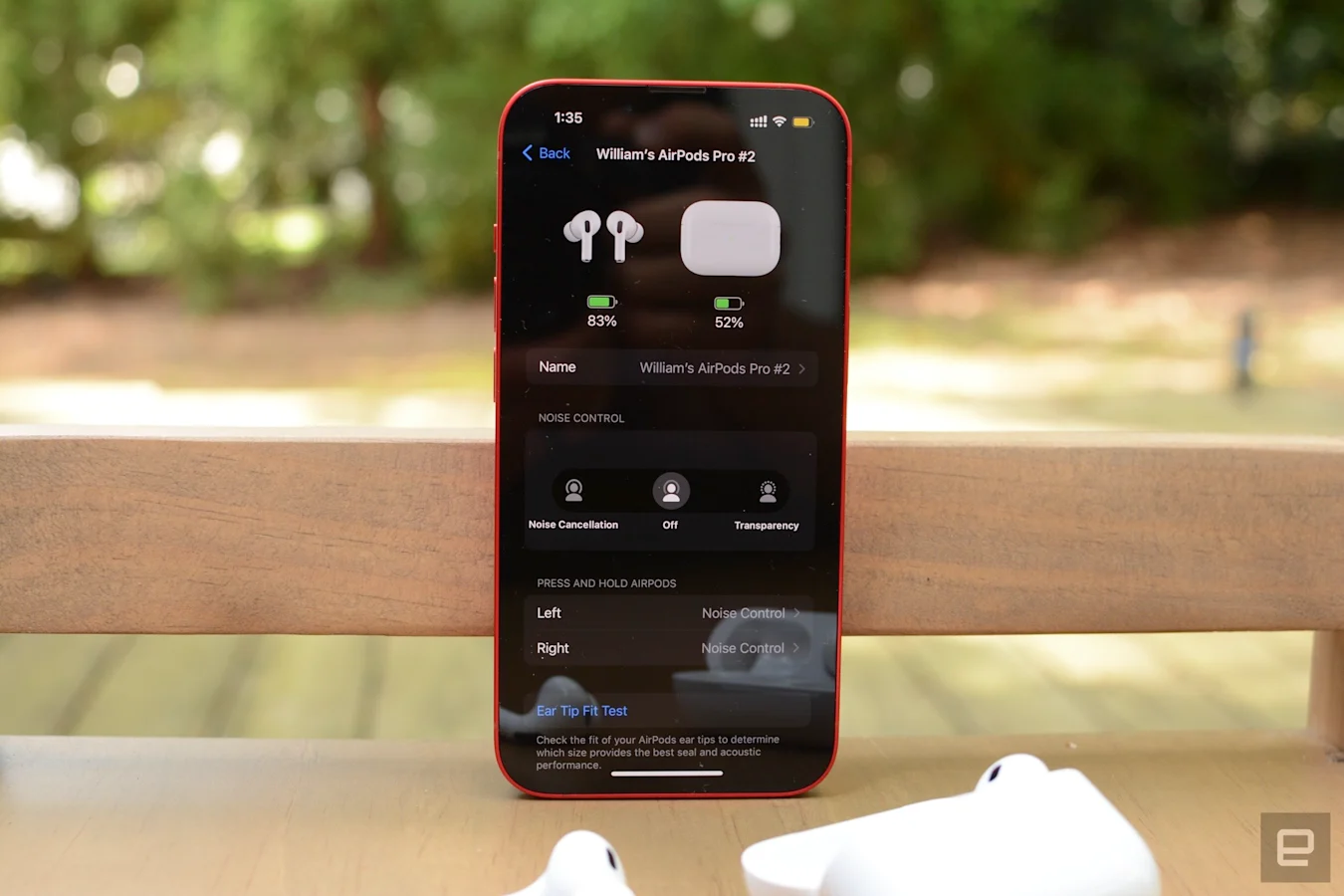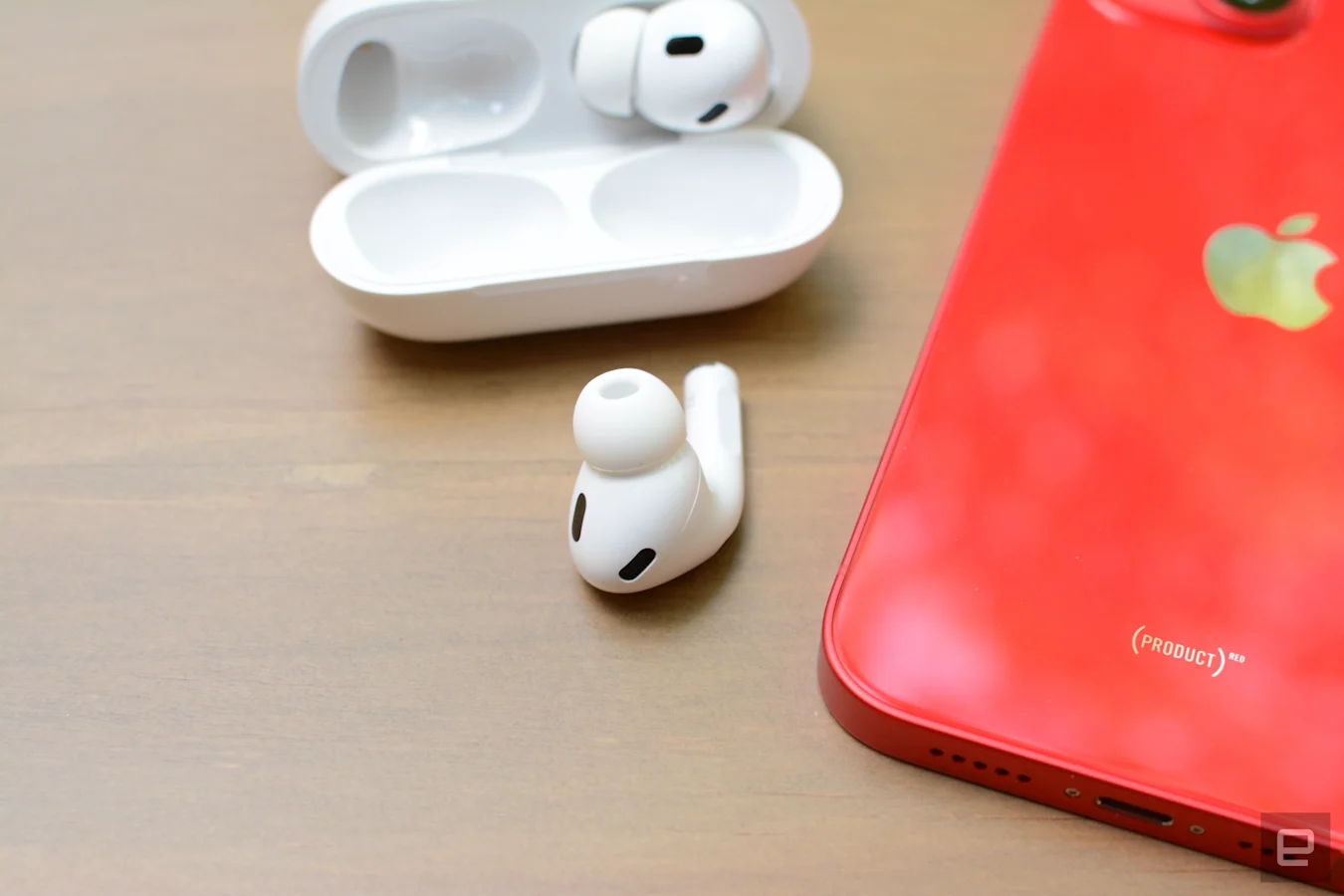Three years ago, Apple finally gave the people what they wanted: active noise cancellation (ANC) in a set of AirPods. That first-generation model retained the overall look of the company’s classic earbuds, but added an ear tip for noise isolation along with a better fit. After a total redesign of the “regular” AirPods last year and introducing some over-ear noise canceling headphones in 2020, Apple finally unveiled its latest premium earbuds alongside the iPhone 14: the second-generation AirPods Pro ($249).
For version 2.0, Apple hasn’t totally re-written the formula. If you were hoping for an updated design for the new AirPods Pro, Apple surely left you disappointed. Instead of a complete overhaul, the company focused instead on the internals, adding several new features and refining what was already there with the help of some new silicon. So, even though Apple didn’t abandon its aesthetic, these AirPods Pro are still vastly different from the previous edition.
pros
- Improved sound
- Stellar transparency mode
- Solid ANC
- Seamless switching between Apple devices
cons
- Same design
- New touch gesture takes practice
- Average battery life
- Personalized Spatial Audio results vary
design
We’re now on our fifth set of earbuds from the company and so far it has only tweaked the look of the “regular” AirPods – and that wasn’t until gen three. Even then, the company kept its stickbuds look, a polarizing design element that has become the hallmark of Apple’s true wireless lineup. Expecting the folks in Cupertino to ditch the stem at this point is likely an exercise in futility, but hey, I welcome Apple to prove me wrong.
Even with the familiar look, there are some small but significant changes. First is something you can’t see: the new swipe gesture. The AirPods Pro stem is still clickable for the core controls (play/pause, skipping tracks, sound modes and Siri), but now the side of that panel accepts swipes. This touch gesture is used to control volume and is mirrored on both sides. Unfortunately, you can’t just swipe it or the earbud will fall out of your ear; you have to use your thumb to brace the stem, just like you would if you were going to press the main button. One addition you can see is the extra small (XS) ear tip size that will improve the fit (not to mention passive noise reduction) for even more people. It’s notable Apple is adjusting these AirPods for small ears in an effort to boost overall performance and comfort.
The other key design changes have to do with the AirPods Pro charging case. First, it has a built-in speaker this time around, making it easier to hear pings when you’re looking for the earbuds or activate tones for low battery, charging and pairing. Accordingly, the grille is now visible on the bottom edge. The case is IPX4 rated just like the AirPods Pro, meaning it, too, is sweat and water resistant. Additionally, there’s now a lanyard loop on one side. In true Apple fashion, there isn’t one included in the box, so the added convenience will cost you more money. The company currently sells a lanyard in its online store from Incase for $13but you can expect other accessory makers to offer alternatives soon enough.
Software and features
Billy Steele/Engadget
All of the features for the AirPods Pro are baked into iOS, so there’s no need to download a separate app to make changes. For this reason, the earbuds pair seamlessly with your phone when you open the case and tap the on-screen pop-up. Just like before, you can quickly access noise cancellation, transparency, spatial audio and head tracking with a long press on the volume slider in the Control Center.
In iOS 16, there’s now a shortcut in the main view of your iPhone settings, saving you the extra taps through the Bluetooth menu. Once you make it to the AirPods Pro settings page, you’ll see battery figures for the earbuds and the case (one number for both). Noise control options for ANC, transparency and turning both off are just below with the ability to reconfigure the long press to activate Siri rather than cycle through those sound modes. Apple’s ear tip fit test also lives in this menu, as do sliders for disabling Adaptive Transparency, in-ear detection, charging case sounds optimized charging and Find My.
Apple has offered Adaptive EQ before, but a new feature for the second-generation AirPods Pro is Adaptive Transparency. This helps when you’re in ambient sound mode by applying a level of noise reduction to loud noises like a siren or a jackhammer. When you sync the AirPods Pro with your Apple Watch, the Noise app will show you how many decibels the earbuds are suppressing in real time. What’s more, that info is then sent to the Health app so you can track auditory exposure levels. Indeed, the AirPods Pro allows you to still hear these things (you’ll want to know about an approaching siren after all), but it noticeably reduces their harshness in the best interest of your ears.

Billy Steele/Engadget
Another new feature Apple introduced on the AirPods Pro is Personalized Spatial Audio. From this main settings menu, you can initiate the process of tuning the device to your ears, which Apple says will improve the immersive quality of Spatial Audio with more accuracy and clarity for directional elements in movies, TV shows and videos. To set it up, you create a personal profile with the front-facing TrueDepth camera on an iPhone. After taking a scan of your face and ears, your phone does the rest.
It’s similar to setting up FaceID, only you capture the sides of your head too. Sony does a similar thing to tailor 360 Reality Audio to each person with a phone camera and a quick scan. Personalized Spatial Audio will also be available on the first-gen AirPods Pro in addition to third-gen AirPods and AirPods Max. And once you configure it, the sound profile syncs across your iPhone, iPad, Mac and Apple TV
The upgraded charging case houses a U1 chip that enables Precision Finding in Find My. Until now, you got a general location for a missing AirPods case. But with the AirPods Pro, Apple offers direction and distance info like it does for AirTags. As a refresher, U1 is the company’s ultra wideband chip that’s been in every iPhone since the 11 for precise location capabilities. The component does the same thing it’s doing for the new AirPods Pro case on AirTags.
H2 chip

Billy Steele/Engadget
Apple’s H1 chip has powered its earbuds and headphones, including Beats products, for years now. The component handles everything Adaptive EQ and active noise cancellation to hands-free Siri. However, every good piece of tech runs its course and on the new AirPods Pro, Apple is introducing the H2. The company says that the new chip not only offers improved sound quality and improved ANC, but it handles new features like Adaptive Transparency.
H2 is more powerful, but it’s also more efficient. With Adaptive Transparency, for example, the chip is capable of on-device processing 48,000 times per second to recognize and quiet those harsh noises you may encounter. For ANC, Apple says H2 can run algorithms that weren’t possible before on devices as small as AirPods. So, when coupled with the drivers, vents and microphones, AirPods Pro cancels double the noise as the first-gen model. H2 also boosts Adaptive EQ with algorithms for improved and more consistent audio performance and works to help you sound more natural when you’re hearing yourself speak in transparency mode.
I know that’s several claims of performance boosts in a variety of areas. But all you really need to know is that the new H2 chip makes everything possible that Apple has either added, improved or refined since the 2019 model.
sound quality

Billy Steele/Engadget
Inside the new AirPods Pro, Apple says new algorithms, amplifier, driver and transducer combine for “richer” sound, increased clarity and consistent performance across volumes and frequencies. It’s a lot of audio jargon, but what you need to know is that the overall sound quality of the second-gen model is massively improved from the first version. Apple wasn’t lying when it promised music would sound better at lower volumes. Even when I turn down the levels, the spacey shoegaze and post-hardcore riffs of The Darling Fire still cut through clean. The band’s atmospheric sound remains intact rather than being compressed down to a muffled murmur. It’s seriously impressive what this new model can do with quieter volume, right down to the bass.
What Apple has done with regular volume is great too. The overall sound is indeed richer with more depth, clarity and a wider soundstage to create a fuller listening experience. The echo on the snaps and the sustain on the low, boomy synth on Lorde’s “Royals” are on equal footing, but at opposite ends of the frequency range. This keeps the track airy and dimensional, showingcasing subtle nuance in both sounds. The sound isn’t just immersive, it’s more detailed too.
When it comes to Personalized Spatial Audio, I actually prefer what the AirPods Pro offer out of the box. Once I scanned my face and ears, the customized sound profile was too heavy on the treble for my taste. Music sounded a bit less immersive and thundering or bombastic elements of movies were slightly muted. Spatial Audio benefits movies and shows more than music anyway, unless you’re listening to one of Apple’s live concerts that was specifically captured for the format. Switch on dynamic head tracking and Luke Combs’ recent Apple Music performance sounds much more lifelike. Songs are noticeably louder and clearer in spatial audio even without head tracking, but the directional element gives things more of a “live” feel with a band on stage.
